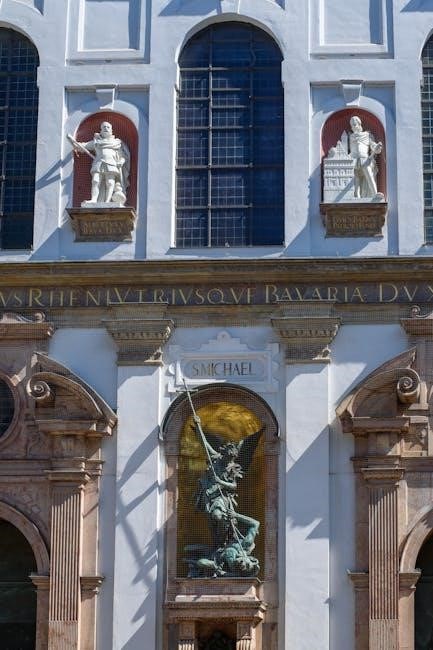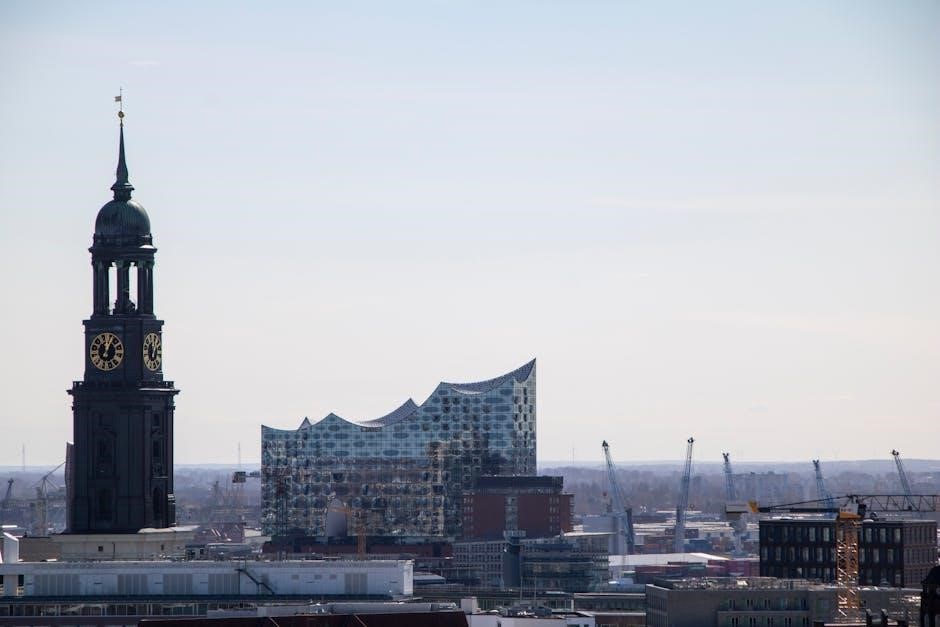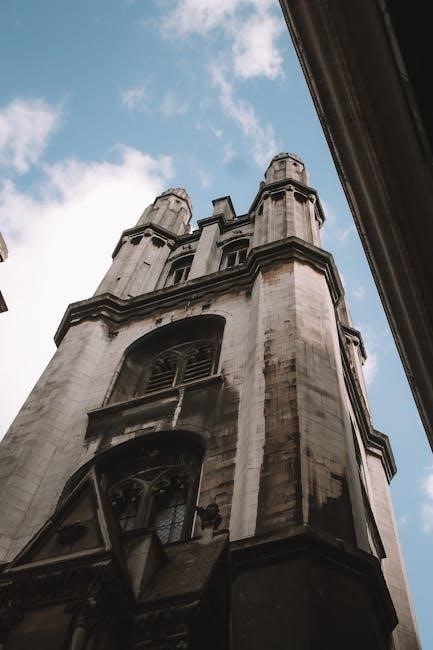
st michael guido reni
Guido Reni, a prominent Baroque painter, left a lasting legacy in art history. His works, such as St. Michael, blend emotional depth with classical clarity, inspiring later artists and captivating audiences with their timeless appeal.
1.1. Biographical Overview of Guido Reni
Guido Reni (1575-1642) was a prominent Italian Baroque painter known for his expressive and harmonious style. Born in Bologna, he trained under Denis Calvaert before joining the Carracci Academy. Reni’s career flourished in both Bologna and Rome, where he was influenced by classical ideals. His personal life, however, was marked by turmoil, including gambling issues and a tragic love affair. Despite these challenges, Reni’s contributions to art remain significant, blending emotional intensity with classical grace.
1.2. Reni’s Artistic Style and Contributions to Baroque Art
Guido Reni’s artistic style epitomized the Baroque era with its dramatic yet elegant compositions. His use of chiaroscuro, harmonious colors, and idealized forms created a sense of serenity and grandeur. Reni’s works often depicted religious themes, capturing emotional depth through gentle expressions and fluid lines. His contributions to Baroque art were significant, as he bridged the classical traditions of the Renaissance with the emotional intensity of the Baroque, influencing numerous artists and shaping the artistic landscape of 17th-century Italy.
1.3. The Significance of Religious Themes in Reni’s Work
Religious themes dominated Guido Reni’s oeuvre, reflecting his deep spiritual devotion and the cultural context of his time. His works, such as St. Michael, often depicted divine subjects with grace and emotional resonance, conveying moral and theological messages. Reni’s religious paintings were not only aesthetic masterpieces but also tools for spiritual devotion, resonating with the Counter-Reformation’s emphasis on art as a means to inspire faith. His ability to balance dramatic composition with serene expressions made his religious art highly influential and enduring in Christian iconography.

The Painting “St Michael” by Guido Reni
Guido Reni’s St Michael captures the archangel’s triumph over Satan, embodying divine grace and heroism. Created in the 17th century, it remains a masterpiece of Baroque art, blending dramatic composition with spiritual depth.
2.1. Historical Context of the Painting’s Creation
Guido Reni’s St Michael was created in the early 17th century, a period marked by the Counter-Reformation and a resurgence of religious art. Commissioned by the Catholic Church, the painting reflects the era’s spiritual fervor and the Church’s efforts to reaffirm its doctrine through art. Reni’s depiction of St Michael defeating Satan symbolized divine triumph over evil, resonating with the theological themes of the time. The work also highlights Reni’s mastery of Baroque techniques, blending dramatic composition with emotional intensity, making it a landmark piece of its era.
2.2. The Composition and Structure of the Artwork
Guido Reni’s St Michael showcases a dynamic yet balanced composition, with the archangel poised in a powerful diagonal stance, spear in hand, dominating the canvas. The painting’s structure emphasizes clarity and harmony, with Reni employing chiaroscuro to create dramatic contrasts between light and shadow. The figure of St Michael is rendered with anatomical precision, while the defeated Satan is shrouded in darkness, reinforcing the theme of divine triumph. The composition guides the viewer’s eye upward, symbolizing ascension and spiritual victory, reflecting Reni’s mastery of Baroque spatial arrangements and emotional expression.

2.3. Symbolism and Iconography in the Depiction of St Michael
Guido Reni’s depiction of St Michael is rich in symbolism, with the archangel wearing a Roman military cloak and cuirass, representing divine authority and strength. The spear he wields signifies victory over evil, while his stance embodies triumph. Satan, depicted as a defeated figure, symbolizes chaos and sin. The painting’s iconography draws from biblical narratives, emphasizing St Michael’s role as a protector and defender of faith. Reni’s use of light and shadow further underscores the spiritual struggle, creating a visual narrative that reinforces the archangel’s divine mission and the triumph of good over evil.
2.4. The Historical and Cultural Significance of the Painting
Guido Reni’s “St Michael” holds profound historical and cultural significance as a masterpiece of 17th-century Italian art. It reflects the religious and political climate of the time, aligning with the Counter-Reformation’s emphasis on reaffirming Catholic doctrine through art. The painting’s dramatic depiction of St Michael defeating Satan symbolizes the Church’s struggle against heresy and evil. Its creation during a period of religious turmoil underscores its role in reinforcing faith and moral values. The work also highlights Reni’s influence on Baroque art, making it a cornerstone of artistic and cultural heritage, celebrated in exhibitions and museum collections worldwide.

The Iconography of St Michael in Art
St Michael is consistently depicted as a warrior archangel, often vanquishing Satan, symbolizing divine justice and triumph over evil. His imagery in art emphasizes strength and moral authority.
3.1. The Biblical and Theological Background of St Michael
St Michael, as depicted in the Bible, is a celestial warrior and leader of the archangels, notably defeating Satan in the Book of Revelation. Theologically, he embodies divine justice and protection, often invoked against evil. His role as a protector of the faithful and a symbol of divine authority is central to Christian doctrine, making him a significant figure in religious art and devotion.
3.2. The Evolution of St Michael’s Depiction in Art History
The depiction of St Michael in art has evolved significantly, reflecting changing theological emphases and artistic styles. Early Christian art often portrayed him as a cherub-like figure, while medieval depictions emphasized his role as a warrior. By the Renaissance, St Michael was frequently shown as a heroic, classical figure, symbolizing divine justice. In Baroque art, such as Guido Reni’s works, dramatic lighting and emotional intensity highlighted his triumph over evil, aligning with the Counter-Reformation’s focus on powerful religious imagery.
3.3. The Role of St Michael in Christian Art and Iconography
St Michael, as a celestial warrior, holds a central role in Christian art, symbolizing divine justice and protection. Often depicted defeating Satan, he embodies the triumph of good over evil. In Guido Reni’s St Michael, the archangel is portrayed with a serene yet powerful demeanor, reinforcing his role as a protector of the faithful. His imagery has been used to inspire devotion and convey theological themes, making him a recurring and significant figure in religious art, particularly during the Counter-Reformation when such themes resonated deeply with the Church’s messaging.

The Painting’s Artistic and Stylistic Elements
Guido Reni’s St Michael showcases his mastery of light and shadow, with harmonic colors and a dynamic composition. His use of chiaroscuro creates dramatic tension, while the balanced forms reflect his classical influences, blending emotional intensity with elegance, characteristic of Baroque art.
4.1. Use of Color and Lighting in the Painting
Guido Reni’s St Michael features a harmonious palette of vibrant yet restrained colors, creating a dynamic interplay of light and shadow. The painting’s chiaroscuro technique highlights the archangel’s divine beauty, with soft, diffused lighting accentuating his form against a dark, ominous background. Golden hues and warm tones evoke a sense of celestial glory, while the contrast between light and dark underscores the battle between good and evil. Reni’s masterful use of color and lighting enhances the emotional intensity of the scene, drawing the viewer’s eye to the central figure and amplifying the painting’s spiritual resonance.
4.2. The Role of Perspective and Space in the Composition
Guido Reni’s St Michael employs perspective to create a sense of depth and movement, drawing the viewer’s eye upward along the central axis of the composition. The archangel’s dynamic pose and the defeated figure of Satan below form a diagonal line, enhancing the painting’s energy. The use of space emphasizes the spiritual realm, with St Michael positioned in a celestial light-filled area, while the dark, compressed space below signifies the underworld. This spatial arrangement heightens the dramatic tension and underscores the triumph of good over evil, creating a powerful visual narrative.
4.3. The Expressive Qualities of the Figures in the Painting
In St Michael, Guido Reni masterfully captures the emotional intensity of the scene through the figures’ expressions and postures. St Michael’s serene yet resolute face conveys divine authority, while his outstretched arm and tense muscles emphasize his determination. Satan, depicted in a twisted pose, exudes anguish and defiance, his contorted features reflecting his struggle; The stark contrast between the archangel’s calm and Satan’s torment heightens the painting’s dramatic impact, creating a vivid emotional narrative that engages the viewer and underscores the spiritual battle’s intensity.
The Painting’s Influence and Legacy
Guido Reni’s St Michael has profoundly influenced Baroque art and beyond, inspiring numerous artists and interpretations. Its dramatic style and emotional depth continue to captivate modern audiences globally.
5.1. The Impact of “St Michael” on Later Artists and Art Movements
Guido Reni’s St Michael significantly influenced later artists, particularly in the Baroque and Neoclassical movements, with its harmonious blend of classical clarity and emotional depth. Reni’s innovative use of color and composition became a model for many, inspiring a wave of religious art that emphasized dramatic yet restrained expressions. His ability to convey spiritual intensity resonated with artists seeking to evoke profound emotional responses, cementing his legacy as a pivotal figure in the evolution of Baroque art and its enduring appeal across centuries.
5.2. The Painting’s Reception and Critique in Art History
Guido Reni’s St Michael has been celebrated for its technical mastery and emotional resonance, yet it has also faced criticism for its idealized forms and lack of dramatic tension. Early art historians praised its classical elegance, while later critics argued it lacked the intense realism of other Baroque works. Despite this, the painting remains a cornerstone of religious art, admired for its serene beauty and spiritual depth, reflecting Reni’s unique balance of tradition and innovation in his oeuvre.
5.3. The Painting’s Place in Museum Collections and Exhibitions
Guido Reni’s St Michael holds a prominent place in museum collections, often displayed as a prime example of 17th-century Italian art. It has been featured in exhibitions dedicated to Reni’s work, such as the notable show at The Bowes Museum, highlighting its cultural significance. The painting’s inclusion in these exhibitions underscores its importance in showcasing the artistic and religious themes of the Baroque era, making it a valuable resource for both scholars and the public to appreciate and study.

The Cultural and Historical Context of the Painting
Guido Reni’s St Michael reflects 17th-century Italian culture, influenced by the Catholic Church’s Counter-Reformation ideals, embodying the era’s spiritual and political dynamics with expressive power.
6.1. The Painting’s Reflection of 17th-Century Italian Culture
Guido Reni’s St Michael mirrors the cultural and religious sentiments of 17th-century Italy. The painting embodies the Baroque style, blending dramatic lighting with classical ideals. It reflects the Counter-Reformation’s emphasis on religious art, commissioned to inspire devotion and reinforce Catholic doctrine. The depiction of St Michael as a powerful, victorious figure resonated with the era’s spiritual and political climate, symbolizing divine triumph over evil. The work also showcases the artistic innovations of the time, with vivid colors and dynamic compositions that captivated audiences and solidified Reni’s reputation as a master painter.
6.2. The Role of the Catholic Church in Commissioning Religious Art
The Catholic Church played a pivotal role in commissioning religious art during the 17th century, including Guido Reni’s St Michael. Such works were often commissioned to promote devotion, reinforce Catholic doctrine, and counter Protestant influences. The Church sought to inspire faith through vivid depictions of biblical themes and saints. Reni’s painting, created during the Counter-Reformation, reflects this agenda, as it portrays St Michael triumphantly defeating Satan, symbolizing divine victory over evil. The work was likely commissioned by a religious order or wealthy patrons aligned with the Church’s goals, making it a powerful tool for spiritual and ideological influence.
6.3. The Painting’s Connection to the Counter-Reformation Movement
Guido Reni’s St Michael aligns with the Counter-Reformation’s goals of reaffirming Catholic doctrine and countering Protestantism. The painting’s vivid depiction of the archangel defeating Satan symbolizes divine triumph over evil, resonating with the Church’s mission to inspire devotion and reinforce its authority. Reni’s work likely served as a visual tool to bolster Catholic identity, emphasizing the Church’s role as a defender of faith. Its dramatic composition and emotional intensity reflect the era’s spiritual fervor, making it a powerful artifact of the Counter-Reformation’s artistic strategies.

The Painting’s Technical and Material Aspects
Guido Reni’s St Michael is executed in oil on canvas, utilizing chiaroscuro and sfumato techniques. The painting features a giltwood frame, enhancing its dramatic presentation and spiritual themes.
7.1. The Materials and Techniques Used by Reni
Guido Reni’s St Michael was painted in oil on canvas, showcasing his mastery of chiaroscuro and sfumato. The use of vivid colors and dynamic brushwork emphasizes the dramatic scene. Reni employed layers of glazes to achieve deep, luminous tones, while his precise draftsmanship ensured anatomical accuracy. The painting’s giltwood frame, often seen in Baroque art, adds a touch of grandeur. Reni’s technique reflects his classical training and innovative approach, blending emotional intensity with technical precision to create a visually compelling and spiritually charged work.
7.2. The Painting’s Conservation and Restoration History
Guido Reni’s St Michael has undergone several restorations to preserve its integrity. In the 20th century, experts cleaned the painting to remove old varnish, revealing its vibrant colors. The canvas was stabilized to prevent further deterioration, and areas of wear were meticulously retouched. These interventions ensured the artwork’s longevity while maintaining its original artistic intent. Today, the painting remains in remarkable condition, a testament to careful conservation practices that honor Reni’s masterful technique and emotional depth.
7.3. The Painting’s Provenance and Ownership History
Guido Reni’s St Michael was originally commissioned for the Santa Maria della Concezione dei Cappuccini in Rome. After its creation in the early 17th century, the painting remained in the church for over a century. It later passed through various private collections, including noble families in Italy and Europe. In the 19th century, it was acquired by a prominent art dealer, leading to its eventual placement in a public museum. Today, the painting is part of a esteemed collection, accessible to scholars and art enthusiasts worldwide, ensuring its cultural significance endures.

The Painting’s Emotional and Spiritual Impact
Guido Reni’s St Michael evokes profound emotional and spiritual resonance, depicting divine triumph over evil. Its vivid imagery and serene tones inspire devotion, reflecting Baroque spirituality.
8.1. The Emotional Resonance of the Painting’s Subject Matter
Guido Reni’s St Michael captivates viewers with its vivid depiction of the archangel’s triumph over Satan, evoking feelings of hope and divine justice. The dynamic composition and dramatic lighting heighten the emotional tension, while the serene expression of St Michael conveys unwavering resolve. The painting’s ability to balance intense action with spiritual calm creates a profound emotional connection, inviting contemplation of good’s victory over evil. This resonance underscores the artwork’s enduring appeal and its power to inspire devotion and reflection in audiences.
8.2. The Spiritual Message Conveyed Through the Painting
Guido Reni’s St Michael embodies a profound spiritual message, depicting the archangel as a divine warrior triumphing over evil. The painting symbolizes the eternal struggle between good and evil, with St Michael representing God’s justice and protection. The artwork’s composition, with its dramatic lighting and dynamic forms, reinforces the idea of divine intervention and salvation. Reni’s depiction of St Michael as a serene yet powerful figure underscores the Catholic Church’s teachings on redemption and morality, making the painting a powerful tool for spiritual reflection and devotion in its time and beyond.
8.3. The Painting’s Role in Devotional Practices and Worship
Guido Reni’s St Michael played a significant role in devotional practices, particularly in Catholic churches. Its depiction of the archangel defeating Satan was often displayed in sacred spaces to inspire worship and contemplation. The painting’s vivid imagery and emotional intensity made it a powerful tool for reinforcing Catholic doctrine and fostering spiritual devotion. During the Counter-Reformation, such works were used to strengthen faith and visually communicate divine triumph over evil, making St Michael a focal point for religious reflection and communal worship in its time and beyond.

The Painting’s Relationship to Other Works by Reni
Guido Reni’s St Michael aligns with his other religious works, showcasing consistent themes of divine triumph and emotional depth. It reflects his mastery of Baroque composition and light.
9.1. Comparisons with Other Religious Paintings by Reni
Guido Reni’s St Michael shares thematic and stylistic similarities with his other religious works, such as Ecce Homo and depictions of saints. Like these, it emphasizes dramatic poses, vivid expressions, and a mastery of light and shadow. However, St Michael stands out for its dynamic composition and the intense emotional charge of the archangel’s triumph over Satan. Reni’s use of color and perspective in this painting reflects his consistent approach to religious art, blending devotion with artistic innovation. The work remains a hallmark of his ability to convey spiritual themes with profound visual impact.
9.2. The Painting’s Place Within Reni’s Oeuvre
St Michael is a cornerstone of Guido Reni’s oeuvre, exemplifying his mastery of religious art during the Baroque period. Created in the 17th century, it reflects his mature style, characterized by harmonious composition and emotional intensity. The painting is part of a series of works Reni produced for churches, showcasing his ability to merge religious devotion with artistic excellence. It stands alongside other notable works like Ecce Homo and Massacre of the Innocents, solidifying Reni’s reputation as a leading figure in Italian Baroque art. His consistent use of light and color underscores his artistic coherence.
9.3. The Painting’s Unique Characteristics Compared to Reni’s Other Works
St Michael stands out in Reni’s oeuvre for its dynamic composition and vivid depiction of the archangel defeating Satan. Unlike his other works, such as Ecce Homo, this painting emphasizes dramatic movement and intense emotional expression. The use of vibrant colors and sharp contrasts creates a powerful visual impact. Additionally, the painting’s focus on a singular, heroic figure sets it apart from Reni’s more narrative-driven works. Its execution during the 17th century showcases Reni’s evolving style, blending classical ideals with Baroque drama, making it a unique gem in his artistic repertoire.

The Painting’s Modern Interpretations and Receptions
St Michael continues to captivate modern audiences with its timeless themes and artistic excellence. Exhibitions highlight its relevance, while contemporary artists draw inspiration from its emotional depth and technique.
10.1. Contemporary Artistic and Cultural Interpretations of the Painting
Contemporary artists and scholars interpret St Michael as a symbol of triumph and moral strength. Its dramatic composition and emotional depth resonate with modern audiences, transcending its historical context. The painting’s universal themes of good vs. evil continue to inspire artistic reinterpretations. Exhibitions worldwide showcase its enduring appeal, while digital reproductions make it accessible to a global audience. Reni’s mastery of light and color remains a benchmark for contemporary artists exploring religious and mythological subjects. The work’s cultural significance is celebrated in its ability to evoke both spiritual reflection and aesthetic admiration across generations.
10.2. The Painting’s Relevance in Modern Religious and Artistic Discourse
St Michael remains a potent symbol in modern religious discourse, embodying divine justice and courage. Its depiction of the archangel resonates with themes of hope and resilience, making it a focal point for spiritual reflection. In artistic circles, Reni’s use of light and composition is studied for its technical brilliance. The painting’s ability to bridge the sacred and the aesthetic continues to inspire interdisciplinary discussions, linking art, theology, and cultural identity. Its relevance endures as a masterpiece that transcends time, speaking to both faith and artistic expression.
10.3. The Painting’s Continued Influence on Contemporary Artists
Guido Reni’s St Michael continues to inspire contemporary artists with its masterful composition and emotional depth. The painting’s dynamic use of chiaroscuro and its balance of drama and elegance serve as a blueprint for modern reinterpretations of religious and mythological themes. Many artists draw from Reni’s ability to convey both power and grace, incorporating these elements into their own works. The painting’s timeless appeal ensures its influence persists, attracting artists across diverse mediums and styles who seek to capture its spiritual intensity and visual harmony in their creative expressions. Its legacy remains a cornerstone of artistic inspiration.

